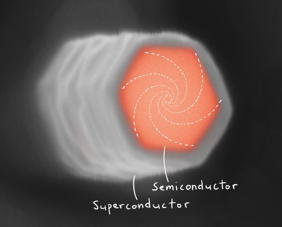Home > Press > A 1960s idea inspires NBI researchers to study hitherto inaccessible quantum states
 |
| Scanning electron micrograph of the measured semiconductor-superconductor hybrid nanowires with an artistic illustration of the elusive vortex states
Credit Saulius Vaitiekenas |
Abstract:
Synthetic superconducting vortices:
Researchers from the Niels Bohr Institute, University of Copenhagen, have created a novel pathway into the study of the elusive quantum states in superconducting vortices. The existence of these was flouted in the 1960s, but has remained very difficult to verify directly because those states are squeezed into energy scales smaller than one can typically resolve in experiments.
A 1960s idea inspires NBI researchers to study hitherto inaccessible quantum states
Copenhagen, Denmark | Posted on June 6th, 2025
The result was made possible by a combination of ingenuity and the expanding research in designer materials created in the labs at the Niels Bohr Insitute. It is now published in Physical Review Letters.
Synthetic superconducting vortices finding a backdoor.
Instead of trying to observe the elusive states in their original setting, the researchers, led by a professor at the Niels Bohr Institute, Saulius Vaitiekėnas, built a completely new material system that mimics the conditions.
Like using a clever backdoor, they bypassed the original limitations by designing a tiny superconducting cylinder and applying magnetic flux to recreate the essential physics.
This setup allows us to study the same quantum states, but on our own terms, says Saulius. By designing the platform ourselves, we dictate the rules.
Studying the elusive states is basic research but where does it lead?
In a growing and very competitive research landscape in quantum, this work demonstrates the versatility of the semiconductorsuperconductor platform to realize and study new types of quantum states.
And the semiconductor-superconductor platform in itself is actually also a Copenhagen innovation from about a decade ago. We actually came across these states serendipitouslylike many scientific discoveries. But once we understood what we were looking at, we realized it was more than a curiosity.
It turns out that they could be useful for building hybrid quantum simulators, which are needed to study and understand complex future materials, Saulius explains.
####
For more information, please click here
Contacts:
Media Contact
Søren Granat
University of Copenhagen – Faculty of Science
Office: 45-35-32-06-05
Expert Contact
Saulius Vaitiekenas
University of Copenhagen
Cell: +45 53 69 08 64
Copyright © University of Copenhagen – Faculty of Science
If you have a comment, please Contact us.
Issuers of news releases, not 7th Wave, Inc. or Nanotechnology Now, are solely responsible for the accuracy of the content.
News and information
![]()
Electrifying results shed light on graphene foam as a potential material for lab grown cartilage June 6th, 2025
![]()
Quantum computers simulate fundamental physics: shedding light on the building blocks of nature June 6th, 2025
![]()
Self-propelled protein-based nanomotors for enhanced cancer therapy by inducing ferroptosis June 6th, 2025
Physics
![]()
Quantum computers simulate fundamental physics: shedding light on the building blocks of nature June 6th, 2025
![]()
Magnetism in new exotic material opens the way for robust quantum computers June 4th, 2025
Quantum Physics
![]()
Quantum computers simulate fundamental physics: shedding light on the building blocks of nature June 6th, 2025
Quantum chemistry
![]()
Three-pronged approach discerns qualities of quantum spin liquids November 17th, 2023
Possible Futures
![]()
Ben-Gurion University of the Negev researchers several steps closer to harnessing patient’s own T-cells to fight off cancer June 6th, 2025
![]()
Researchers unveil a groundbreaking clay-based solution to capture carbon dioxide and combat climate change June 6th, 2025
![]()
Cambridge chemists discover simple way to build bigger molecules one carbon at a time June 6th, 2025
![]()
Self-propelled protein-based nanomotors for enhanced cancer therapy by inducing ferroptosis June 6th, 2025
Chip Technology
![]()
Programmable electron-induced color router array May 14th, 2025
![]()
Enhancing power factor of p- and n-type single-walled carbon nanotubes April 25th, 2025
![]()
Ultrafast plasmon-enhanced magnetic bit switching at the nanoscale April 25th, 2025
![]()
New ocelot chip makes strides in quantum computing: Based on “cat qubits,” the technology provides a new way to reduce quantum errors February 28th, 2025
Discoveries
![]()
Researchers unveil a groundbreaking clay-based solution to capture carbon dioxide and combat climate change June 6th, 2025
![]()
Cambridge chemists discover simple way to build bigger molecules one carbon at a time June 6th, 2025
![]()
Electrifying results shed light on graphene foam as a potential material for lab grown cartilage June 6th, 2025
![]()
Self-propelled protein-based nanomotors for enhanced cancer therapy by inducing ferroptosis June 6th, 2025
Materials/Metamaterials/Magnetoresistance
![]()
Researchers unveil a groundbreaking clay-based solution to capture carbon dioxide and combat climate change June 6th, 2025
![]()
Institute for Nanoscience hosts annual proposal planning meeting May 16th, 2025
![]()
Enhancing power factor of p- and n-type single-walled carbon nanotubes April 25th, 2025
Announcements
![]()
Electrifying results shed light on graphene foam as a potential material for lab grown cartilage June 6th, 2025
![]()
Quantum computers simulate fundamental physics: shedding light on the building blocks of nature June 6th, 2025
![]()
Self-propelled protein-based nanomotors for enhanced cancer therapy by inducing ferroptosis June 6th, 2025
Interviews/Book Reviews/Essays/Reports/Podcasts/Journals/White papers/Posters
![]()
Cambridge chemists discover simple way to build bigger molecules one carbon at a time June 6th, 2025
![]()
Electrifying results shed light on graphene foam as a potential material for lab grown cartilage June 6th, 2025
![]()
Quantum computers simulate fundamental physics: shedding light on the building blocks of nature June 6th, 2025
![]()
Self-propelled protein-based nanomotors for enhanced cancer therapy by inducing ferroptosis June 6th, 2025










